Designing for human variability with 3D scanning
At the Vision Lab of the University of Antwerp, new technologies have been developed to deal with human variability in product design. The effectiveness of the approach has already been proven in the design process for earphones, the construction of fracture fixation plates, modelling of head variability, etc.

Situation before
The human body is a complex shape with many variations of which a thorough understanding is needed in order to design functional and comfortable wearable products, like protective gear, head-sets, sports clothing, and orthotics. Current design approaches rely on 1D anthropometry and unrealistic, linearly scaled ISO-mannequins. Many design-prototype-testiterations are required before a satisfying result is obtained. However, with the uprising of 3D scanning technology an enormous amount of 3D data becomes available for the product developer. Unfortunately, it is not yet clear how this wealth of information can be leveraged for improving their products.
Technology
The Vision Lab and the Product Development department are tackling this problem. Togethe rwith the client, they will gather 3D scans of the relevant body part for a representative sample of the target population. Usingstate-of-the-art processing techniques, they structure the 3D-scan database into 3D statistical anthropometric models that provide a concise parameterization of the 3D human body shape with anthropometric parameters. These models are then made available to the client in standard CAD-software where they can be used for:
• quantitative and qualitative exploration of 3D shape and size variation within a target population;
• devising product and target-group specific sizing systems, e.g. one-size-fits-all or N-sizes-fit-all;
• dynamic linking of CAD designs to 3D shape models for easy mass-customization of the product. This approach leads to a better product delivered in a shorter time frame.
About the researchers -research unit
The research domain of Vision Lab is digital image processing and pattern recognition in general. The long term research of Vision Lab aims at the development of advanced statistical techniques for the processing and analysis of imaging material. This includes model based statistical techniques and multi resolution techniques, with applications in image reconstruction, restoration, segmentation and classification. The research is validated in 2 domains of application: biomedical imaging and remote sensing. The Product Development department does researches on product development methodologies and techniques with proven added economical, technical, or usability value. The focus is primarily on valorization and targets complementarity with the fundamental research output of the University of Antwerp.
More information
University of Antwerp
Valorisation Office
Middelheimlaan 1
2020 Antwerpen - Belgium
T +32 3 265 88 84